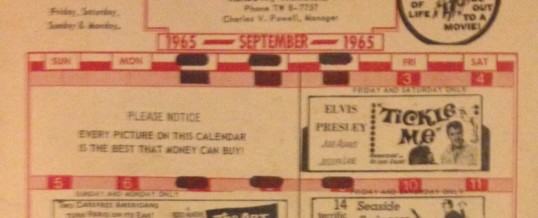
It was 50-cents to get in. The additional 50-cents my mom gave me covered the cost of popcorn and a Coke, plus more if I wanted a giant dill pickle.
Williams Theater was an institution in my hometown of Ashdown, Arkansas. Wedged between the store that sold Buster Brown shoes and Piggly Wiggly, generations of residents walked through its doors to enjoy an afternoon or evening away from their cares.
The first girl I ever went steady with, I met there.
The family who started the theater in the late 1940s was named Williams, but ownership had long belonged to others by the time I spent my Friday nights there with friends watching the newest films of the day. From what I was told, the theater was part of a chain that began in DeQueen, Arkansas.
During the mid-50s, my dad was a projectionist there. He screened movies starring Grace Kelly, James Dean, and other legends, and told stories of the mixture of heat and smoke from the arcing rods required to generate the light through the lens. That, plus the cigarettes from the patrons in the balcony and the seats far below meant that he truly earned his money.
The ceiling was one long arch shape from front to back. This followed the contour of the exterior of the building, which is called a quonset design (picture an old, metal airplane hangar). The lights were inset in the recessed ceiling that gave just enough illumination so that you wouldn’t trip on your way to the snack bar, but not so much that it interfered with the picture on the screen.
I mentioned the balcony. By the time I went to the movies without an adult, the balcony was no longer used on a regular basis. Exceptions were made for multiple sold out showings, such as Disney films or low-budget flicks, including The Legend of Boggy Creek or Chariots of The Gods, which had people lined up for tickets and was standing room only.
I remember having to manage my soda pop intake during the sold out movies. If you got up for a bathroom break, someone else would take your seat.
Of the three seating sections, which included a wide center section and two narrow sections (one on each side), my friends and I always angled for the very back of the center row. This allowed for us to cut up, or during our teen years, sneak a kiss from our girlfriends.
Not much changed with the exterior and decor over the years. The facade of the building had a decidedly Art Deco look, which is interesting since it was constructed after that period of architecture had officially ended. The marquee sign had the obligatory neon and circus-style lights, which highlighted the name of the picture, spelled out in hand-placed letters.
To the right of the movie screen was a clock with a dim neon light that circled the face. It allowed you to know how many minutes were left before your mom was going to pick you up, or when I was older, how how much time I had left before my girlfriend had to be home.
The ticket window and snack bar were virtually unchanged and looked like 1950 as late as the 1970s. The popcorn machine ran constantly and the glass case was filled with Junior Mints, Milk Duds, Sugar Babies, and boxes of plain and peanut M&M’s.
Upcoming film posters were placed in chrome cases behind glass panes. Every now and then, movie promo cards were seen on the snack bar next to the giant pickle jar. Cardboard handouts that featured the next month’s movie lineup were free for the taking. My parents still have one in a frame at their home.
Some of my favorite times were had in that theater. Another girlfriend (hindsight, I seemed to have had a preference for finding girls at the movies) was there often. Her grandfather owned it during my high school years. He was a nice, balding fellow with an ever-present cigar protruding from the corner of his mouth.
She and I would sit in the back and hold hands when she wasn’t helping him in the lobby area.
There was a small stage below the screen, indicating that the theater had also been used for live shows, but I never saw a live performance there. Later, live shows would be all that were to be seen at Williams Theater. Like many locally-owned movie houses, it eventually closed.
I assume it was the victim of home movie rentals and the large cineplexes. Williams Theater ceased showing films not too long after I moved away for college. Likely, there just wasn’t enough business and it was too difficult to compete.
Someone else bought it and turned it into the Ashdown Jamboree. Local country music talent performed. I never attended, but I was told that much of the theater’s interior was gutted and some of the seats removed.
Before writing this, I did a search online to see what I could find about its current status. Photos and videos show dilapidation and neglect. Someone posted a video saying they were trying to save it as a community center. I have no idea how recent the video was posted, but I’m told no progress has been made and nature is taking its toll.
The utilities were long since turned off and there are holes in the once-beautiful ceiling.
One of the more recent photo shows the neon clock. It once told us the time. It now tells us that its own time has passed.
©2018 John Moore
John’s book, Write of Passage: A Southerner’s View of Then and Now is available on Amazon.
Email John at John@thecountrywriter.com.
FEB
2018
